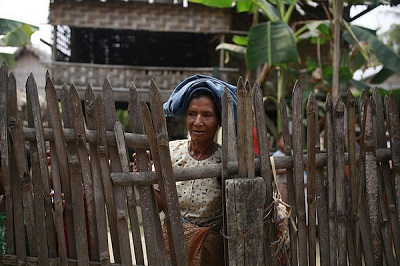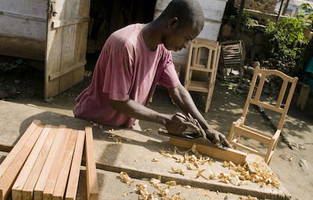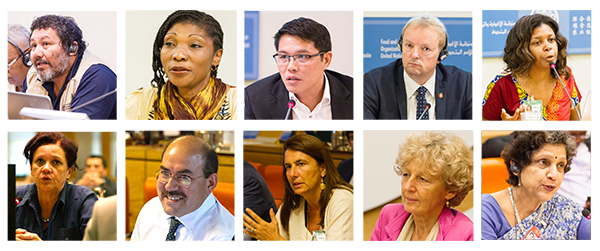Wednesday 21 July
Forest peoples and the Paris Agreement
Following its adoption in December 2015, the Paris Agreement is now expected to be ratified in September this year. While welcoming this development, participants at a day-long event organized by the FAO Forestry Department, the Forest and Farm Facility and regional partners urged the international community to place forest peoples and communities at the heart of climate change initiatives.
In a closing joint statement, participants called for government and international agencies to recognize the roles of local communities, indigenous peoples, smallholders, women, youth, and other vulnerable populations and their forest and farm producer organizations, and to directly and effectively engage them as the enabling actors to address climate change. The overriding common position is that, for climate change actions to succeed, securing land tenure and indigenous people’s rights should be recognized as a priority.The event also emphasized issues of gender, citing examples of what this means in the forest, and learned of examples of several successful local community and indigenous peoples’ engagement in climate change initiatives. Sweden’s experience was that providing farmers with incentives to plant trees is essential for sustainable restoration.
- Indigenous peoples are the ones providing the solution.
Victoria-Tauli Corpuz, UN Special Rapporteur on the Rights of Indigenous Peoples
- Women own fewer assets and they are not secured equal returns.
Terje Halleland, State Secretary of the Norwegian Ministry of Agriculture and Food
- In Africa, women are responsible for 82 percent of food production. They are also very active in tree nursery and tree planting and are leaders in adaptation and mitigation activities at local level.
Cécil Bibiane Ndjebet, Founder and President of REFACOF, UNFF Women's focal point
Read more about the WFW5 day-event "Unfinished agenda for forests and climate change: local communities and smallholders and their organizations as the enabling actors to address climate change" at the Forest and Farm Facility website.

- ©FAO/Hkun Lat
A local woman in Yane village near the Monywa, Saggaing Division, in Myanmar.
Forests and Wood products: propelling a low-carbon future

- ©FAO/Giulio Napoliitano. Boma, Democratic Republic of the Congo. A carpenter working at a sawmill on a piece of wood using a block plane. Renovation of agricultural and forestry research in the Democratic Republic of the Congo.
Wood’s lesser known but equally significant role and potential as a substitute for fossil-fuel intense products is now markedly clearer, following the release of a new FAO Forestry Paper Forestry for a low-carbon future: Integrating forests and wood products in climate change strategies. Growing out of an international online conference held in 2015, the publication, written through the online collaboration of more than 100 experts, provides numerous illustrations of how trees in a "virtuous cycle" not only remove carbon during their life cycle but after felling can continue to store it.
Citing a range of examples, the publication indicates how the use of sustainably sourced wood can contribute to climate change mitigation measures, thereby helping to expand a low-carbon economy. These bonuses complement forests’ emission reduction from deforestation and forest degradation and enhancement of carbon sinks through reforestation, afforestation and sustainable forest management.
Benefits occur at various scales, from the use of wood to construct homes and furniture, biomass used for heating, cooking and sterilizing water, to industrial-scale energy production that uses wood pellets burned as fuel.
Interest in the publication is expected to extend beyond policymakers and experts to engineers, architects and designers, where it could serve as an important resource for rural and urban planning and energy sector development.
Public perceptions of forestry 'need to change'
Public perceptions of forestry need to change, a World Forest Week session on forest communications heard this week. At the session, How do we lead forestry out of the woods?, founding partner and head of strategy for M&C Saatchi Abel (South Africa) Robert Grace argued that forest communications need to engage on a human level, moving away from statistics, in order to shift negative perceptions of forestry issues.
The wider public is tired of hearing the same messages and also cannot connect to messages that are too long and too complex, Grace warned.
Read more in the FAO webstory: Public perceptions of forestry needs to change and visit the Forest Communicators Network website.
Follow-up to the Second International Conference on Nutrition: COFO/2016/7.4

- ©FAO/Yunita. Kopjanski, Indonesia. Unforgettable forest jegkol fruits. FAO Regional Office for Asia and the Pacific, Forests and People photo contest.
In November 2014, by adopting the Rome Declaration and the Framework for Action at the Second International Conference on Nutrition (ICN2), world leaders renewed their commitment to establish and implement policies aimed at eradicating malnutrition in all its forms and transforming the food systems to make nutritious diets available to all. Forest products can directly contribute to meeting nutritional requirements of populations, by providing staple foods, protein and micronutrient-rich food sources.
In addition, woodfuel from forests contribute significantly as a source of energy for food processing and water sterilization. Forest products can also be an important safety net for vulnerable households especially during the lean seasons when food is in short supply. FAO has embarked on a number of activities to support member countries to enhance the contribution of forest products to food security and nutrition.
Read more in COFO Document COFO/2016/7.4
Forest-landscape restoration collaboration set for next stage
The Bonn Challenge is a global aspiration to restore 150 million hectares of the world’s deforested and degraded lands by 2020. As such, it will make a major contribution to the accomplishment of various Sustainable Development Goals by 2030, including the Land Degradation Neutrality target. Enhancing collaboration at the regional level will be critical for countries when developing innovative approaches and incentives for sustainable forest management and conservation, to share knowledge and mobilize finance for implementation of their Bonn Challenge pledges.
These considerations lie behind the recent decision of FAO and the International Model Forest Network (IMFN) Secretariat to sign an agreement, with an initial focus on landscape approaches from 2016–2018, that formalizes and consolidates 17 years of FAO-IMFN collaboration.
An important aspect of future activities will be to develop a greater understanding of the dynamics of forest and landscape restoration and to scale up the restoration of forested landscapes at the regional level, with consequent benefits for climate change adaptation and mitigation and improvements in the livelihoods of forest-dependent people. Lessons learned in implementing the agreement will be integrated in national policy frameworks.
Voluntary guidelines on national forest monitoring: COFO/2016/7.2
COFO23 has adopted new voluntary guidelines on national forest monitoring, thereby enriching the technical resources at countries’ disposal for assessing their natural resources.
High-quality, reliable and accessible information on forests is needed for reporting to many international agreements and to monitor progress towards the Sustainable Development Goals. It is also fundamental for improving the management of forest resources and informing policies related to forests and ecosystem protection and conservation.
However, forest monitoring is a complex, scientific-technical exercise that for many developing countries can also give rise to organizational and institutional challenges, and existing mechanisms and processes do not adequately capture timely forest information at different scales. It is for this reason that the 21st Committee on Forestry recommended that FAO continue its support to countries in strengthening national forest information systems and that it prepare voluntary guidelines on national forest monitoring which take account, in particular, of the requirements for REDD+.
Read more in COFO document COFO/2016/7.2
Scaling up the development of SSFE in Africa

- ©FAO/Giulio Napolitano. Niamey, Niger. Women cleaning Ovalifolia Moringa seeds.
In Africa, many countries have adopted policies favouring decentralized forest management, with communities being granted rights to manage community forests and to derive income from the commercialization of forest products. This has prepared the ground for small-scale forest enterprises (SSFE). However, many SSFEs in Africa are relatively unorganized and operate less than optimally. To help them move to more professional and productive levels, strategic planning and collaboration with key SSFE development actors in Africa is called for.
At an WFW5 side event, FAO described its work with its partners, which includes an expert meeting and two large projects: in Central Africa (Burundi, Chad, Equatorial Guinea, Rwanda and Sao Tome and Principe) funded by the Congo Basin Forest Fund and the African Development Bank; and in Zimbabwe, the EU-funded Forest Forces project supporting multiple SSFE activities.
SSFEs' development hinges on progress in four areas: improving the policy, legal, financing and institutional frameworks conducive to SSFE development; targeted SSFE-product research and innovation, particularly the sustainable domestication of promising non-wood forest products (moringa, marula, shea tress etc); innovative financing mechanisms suited to SSFE activities; and capacity development for forest small-holders and community groups.
Read more about FAO's work on small-scale forest enterprises.

